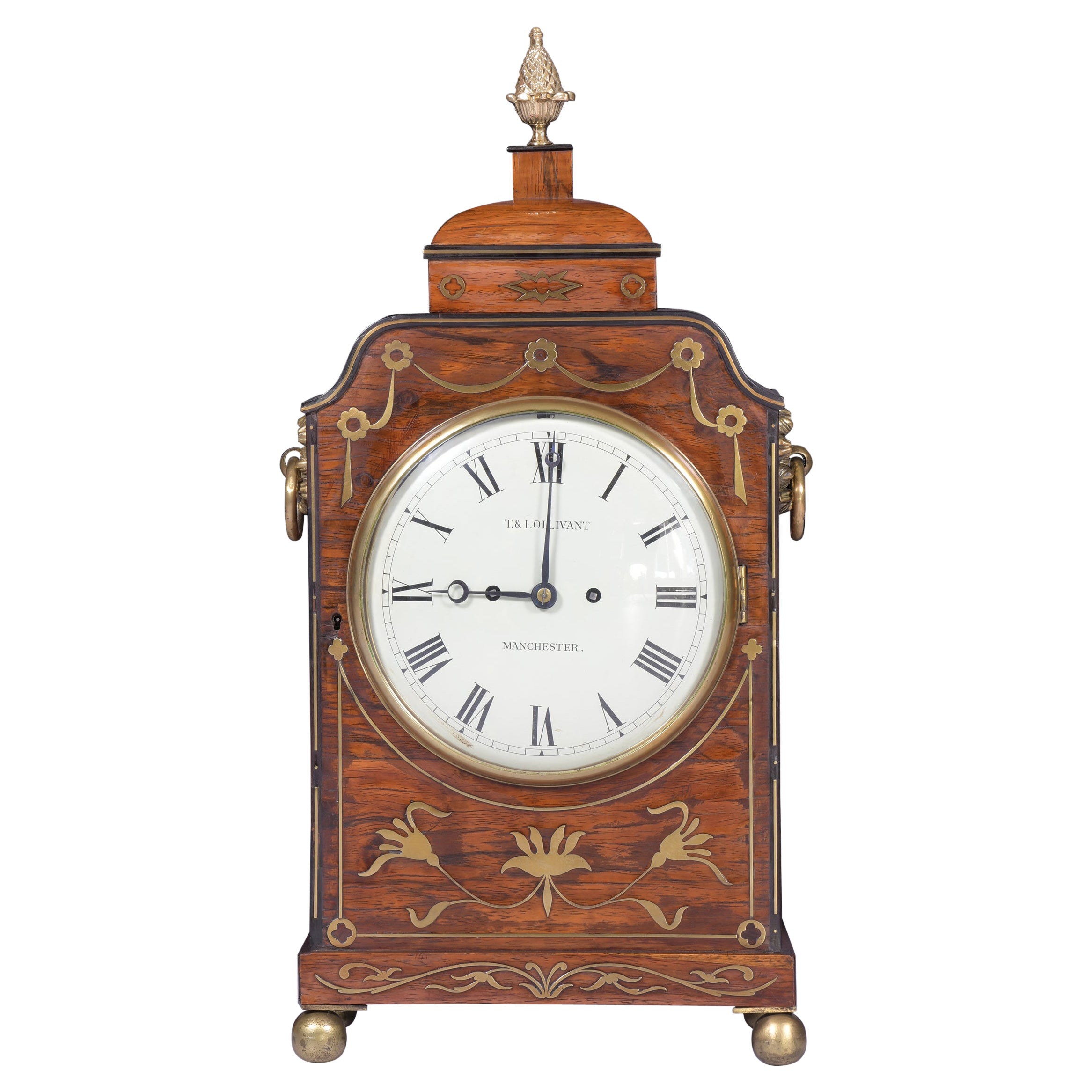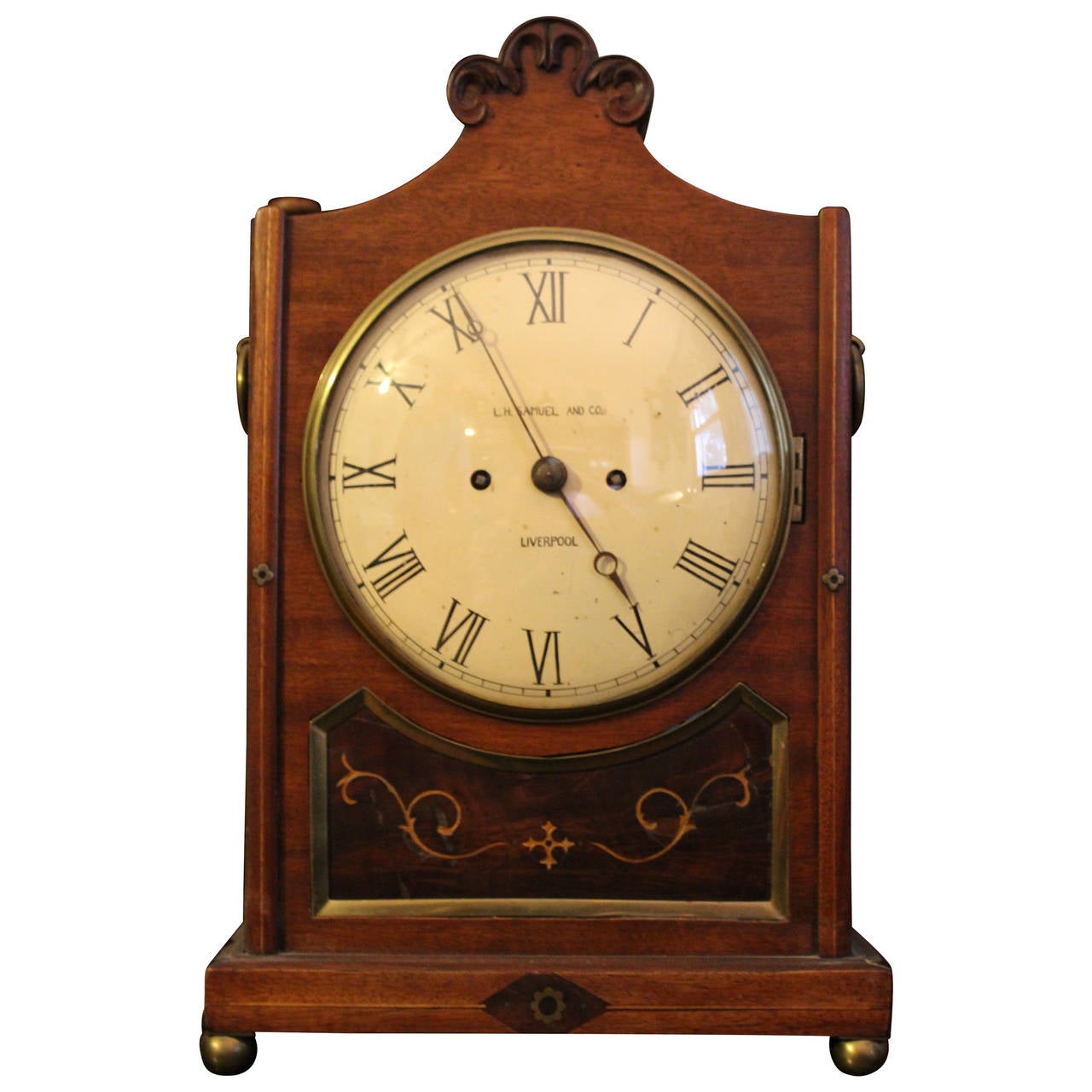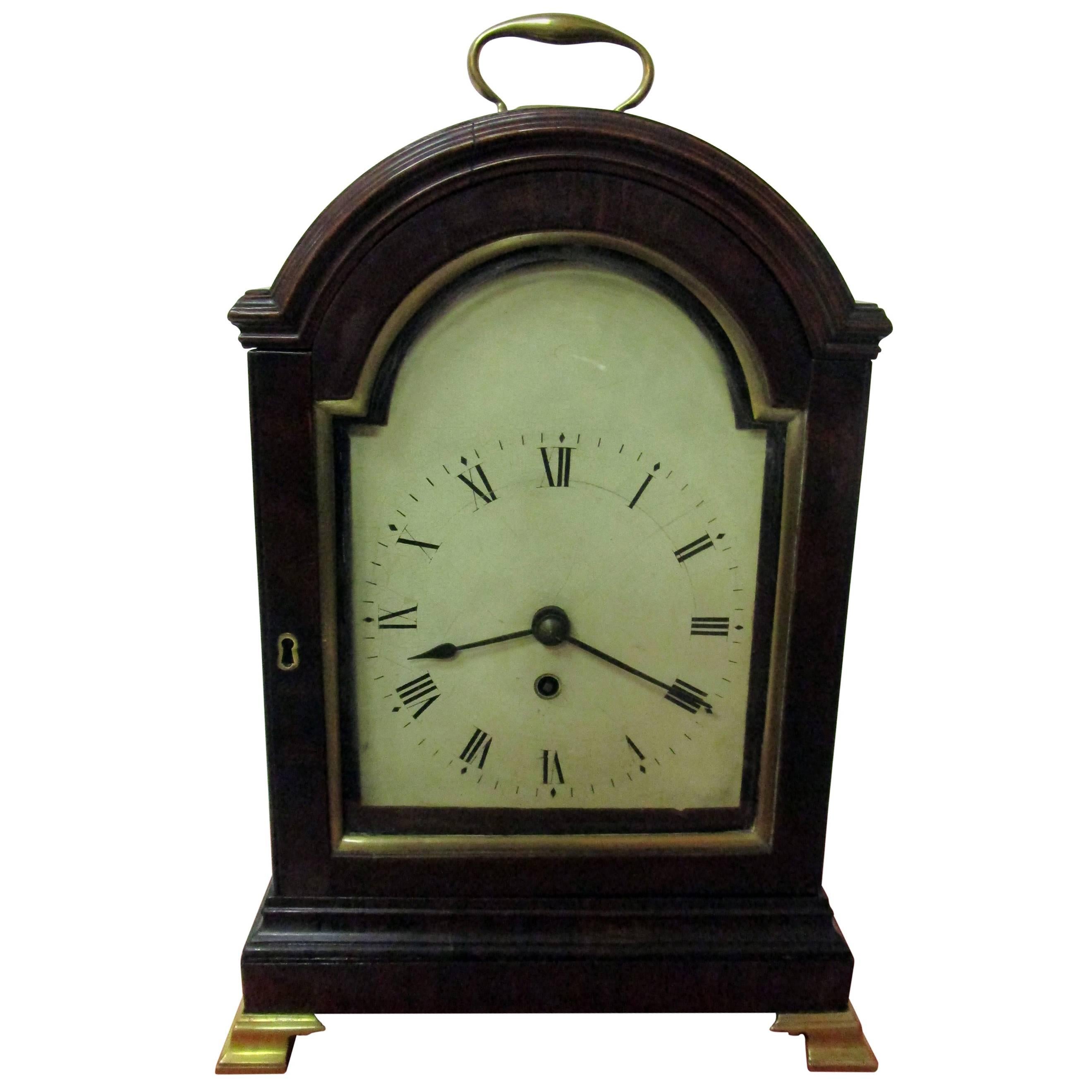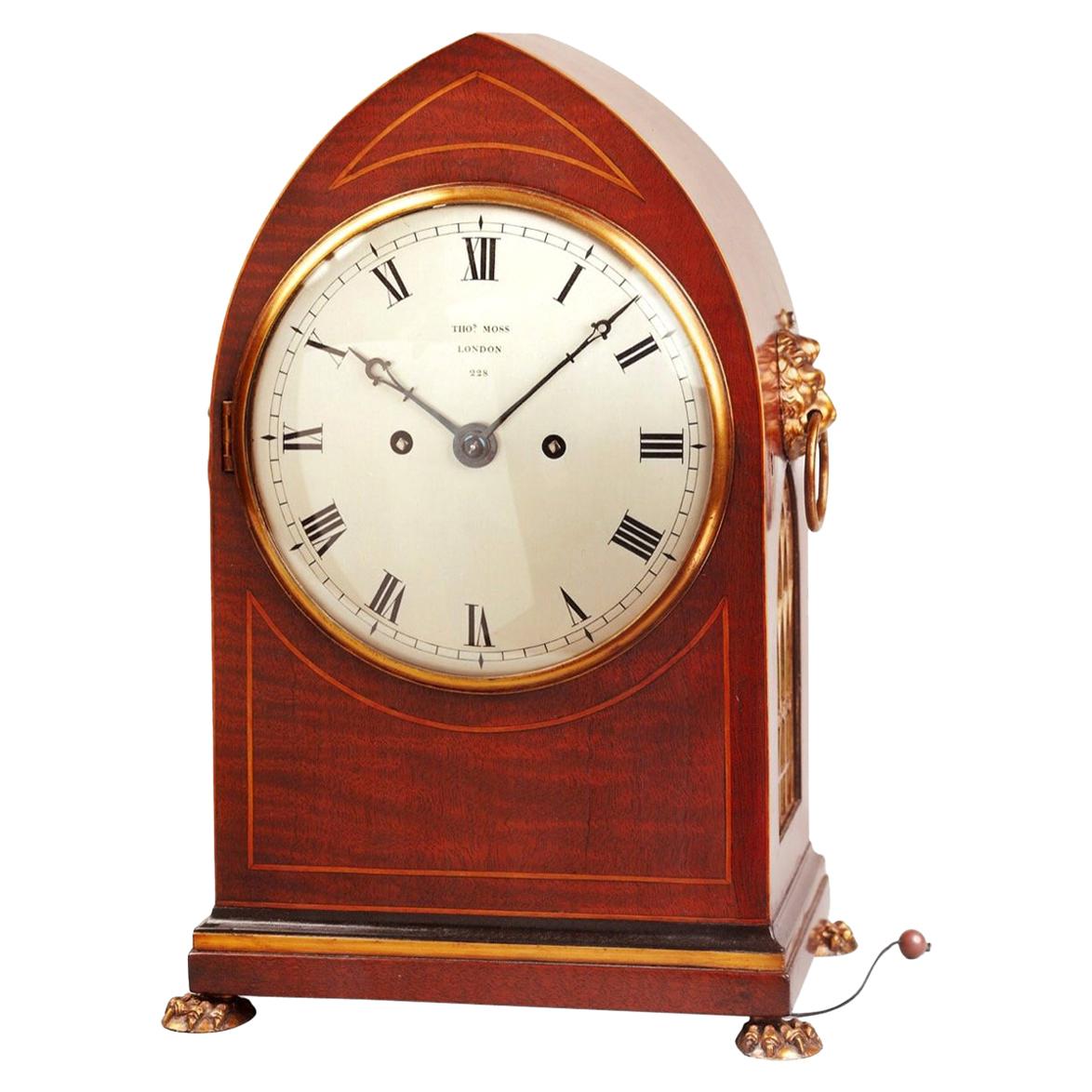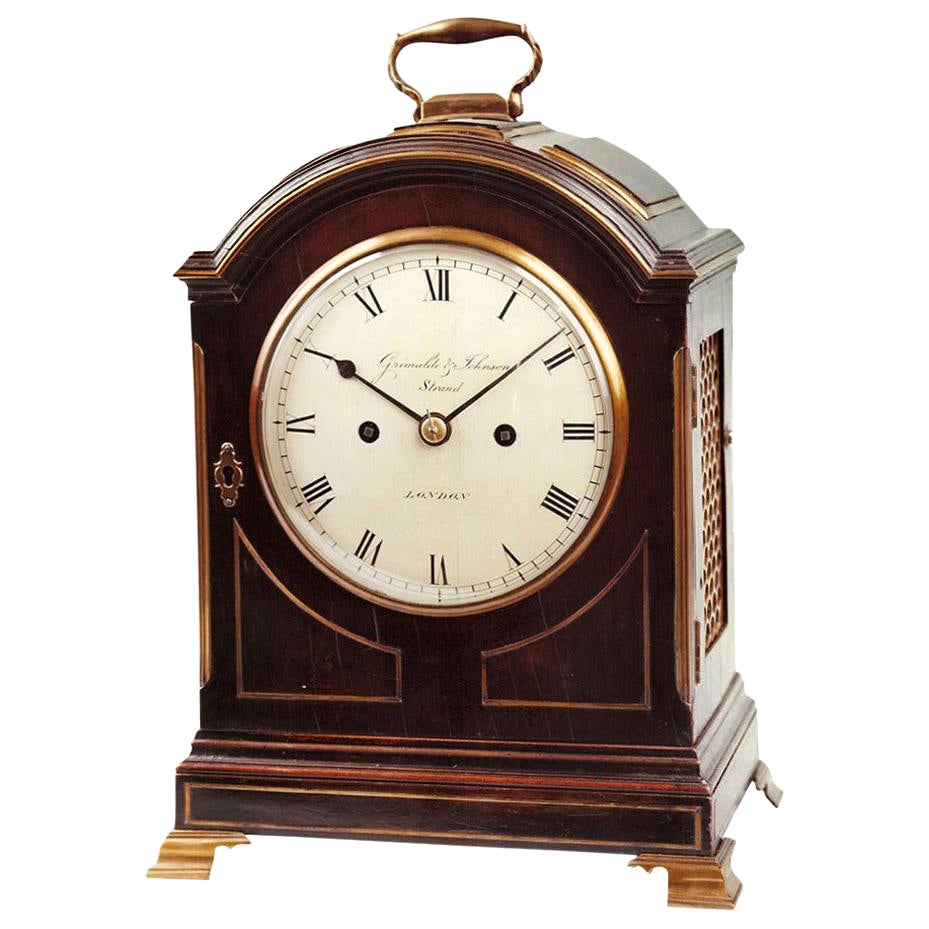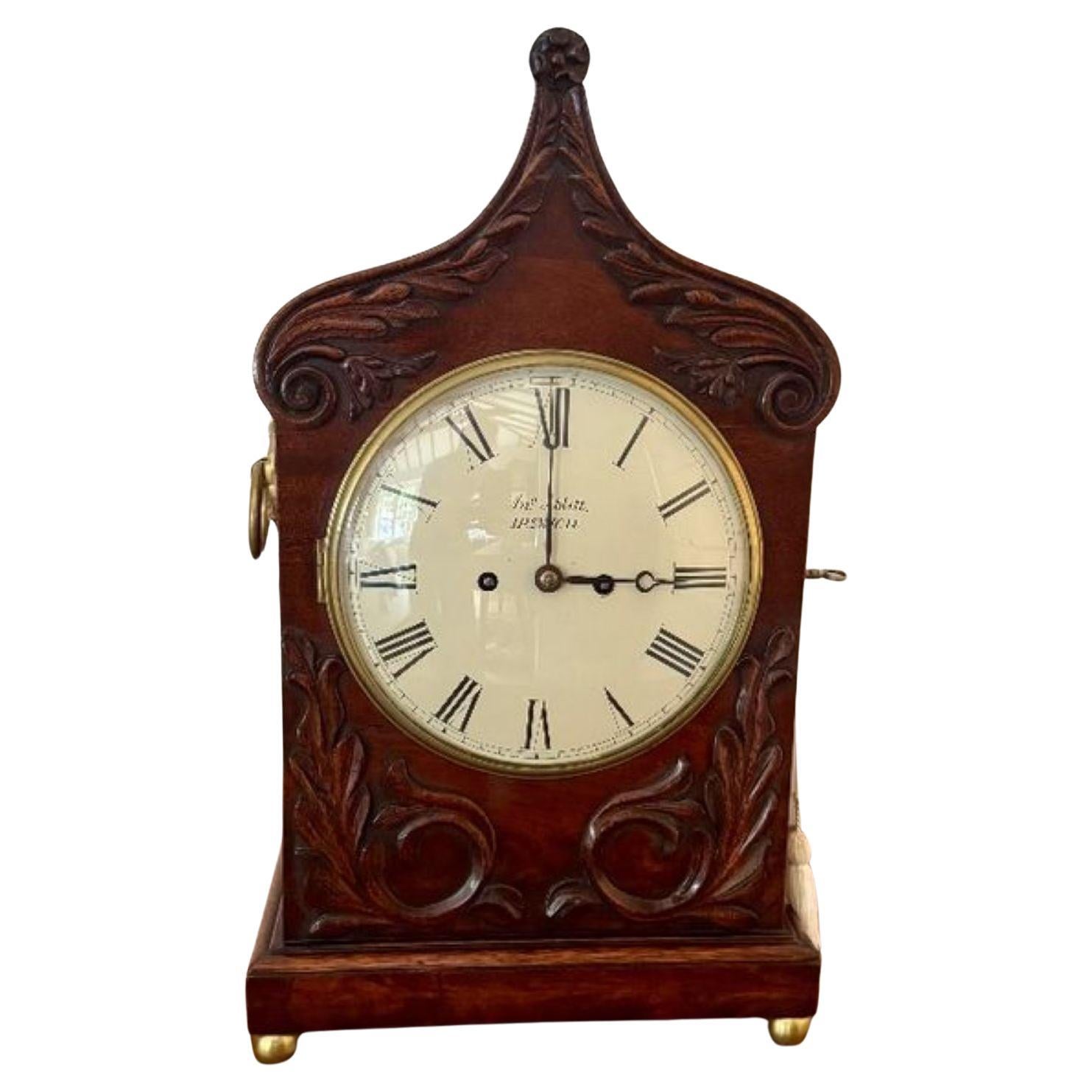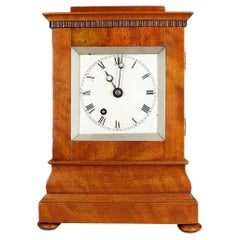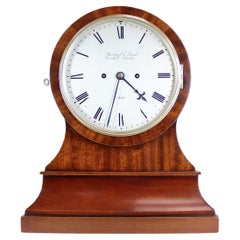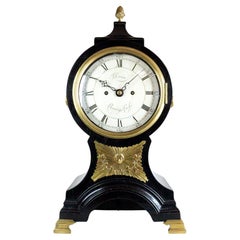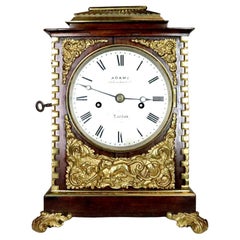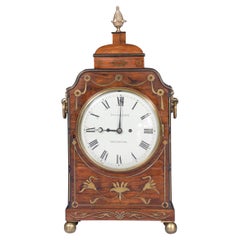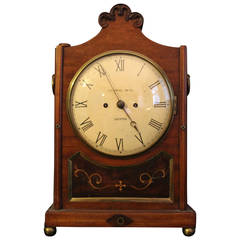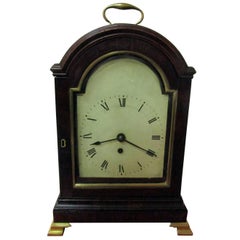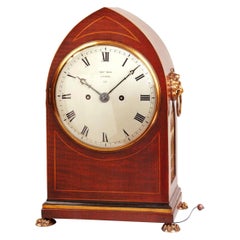Items Similar to A Paul Philip Barraud Bracket Clock in the manner of Thomas Hope
Want more images or videos?
Request additional images or videos from the seller
1 of 17
A Paul Philip Barraud Bracket Clock in the manner of Thomas Hope
$14,762.84
£10,930
€12,730.42
CA$20,649.52
A$22,597.33
CHF 11,851.27
MX$270,086.12
NOK 149,562.31
SEK 139,523.58
DKK 95,072.68
About the Item
A very striking twin fusee bracket clock in an Egyptian revival style case by Paul Philip Barraud. The eight day movement with unusual round plates of thick brass engraved on the back and signed Barraud Cornhill LONDON. With an engraved pendulum of stirrup regulation and rack striking on a bell. The movement is housed behind a painted roman dial also signed Barraud LONDON.
The case is highly unusual with only one other example known. The Egyptian influenced inlay is reminiscent of designs by Thomas Hope in his influential Household Furniture and Interior Decoration published in 1807. The Mahogany case with gothic ebony column clusters supported on lions paw feet, and lancet top is surmounted by a pyramid with decorative and extremely fine marquetry inlay. The sound vents on each side of very idiosyncratic design in brass fretwork backed with dark blue velvet. The case design reflects the highly eclectic style of the late Georgian/Early Regency period and in particular the influence of Thomas Hope.
Paul Philip Barraud moved his company to the Cornhill premises in 1808, In 1809, the oldest child, Frederick Joseph, joined his father in partnership of the firm, at which point the name of the firm is changed to 'Barrauds'. This means we can confidently date this clock to 1808-1809, as the clock is marked with the Cornhill address but still signed in the singular BARRAUD. This date is important as it coincides closely with the publication of Hope’s decorative treatise and shows the influence of the Egyptian style in London at this time.
The Barraud family were an important family of clockmakers, originally French Huguenots, they arrived in London following persecution in France. Francis-Gabriel Barraud was born in 1727 and was a watchmaker by trade. With his elder son Paul Philip, born in 1752, and younger son John, he would establish the Barraud horology firm. By 1782 they were established in Fleet Street and were listed in trade directories simply as 'Barrauds'. Paul Philip seems to have focused on clocks, as several orders for movements by Thwaites are found in his name only. Shortly after this point, in 1795, Francis-Gabriel died, and Paul Philip took control of the firm signing his clocks BARRAUD. By the end of that same year, Paul Philip had entered into partnership with another horologist, George Jamison, and they began to manufacture chronometers. Barraud and BArraud and sons would late go on to win logitude prizes for their chronometers and supply the admiralty.
Paul Phillip Barraud was master of the Worshipful Company of Clockmakers twice in in 1810 and 1811, a mark of the esteem he was held in as it was highly unusual to be master for two consecutive years.
Interestingly this clock is stamped ROBSON 2150 on the front plate and also in the spring barrel caps, this suggests the movement was actually made by William Robson, who although a master horologist in his own right often manufactured clock movements for other clock makers just as Twaithes had done. William Robson was Master of the Clock Makers Company twice in 1809 & 1816 and died in 1823, so this clock has the hand of two of Georgian London’s top clockmakers present in it’s creation.
There are examples of Barraud’s work can be found in the British Museum, the Science Museum, The Royal Observatory and the London Guildhall Collections.
This clock has been overhauled in our workshop and comes with our two year guarantee.
59cm H x 31cm W x 18cm D
BARRAUD, the story of a family. By E.M. Barraud.
WATCHMAKERS AND CLOCKMAKERS OF THE WORLD By G.H. Baillie,
The Georgian Bracket Clock, 1714-1830 By Richard Barber
English Bracket and Mantel Clocks By Andrew Nicholls
- Dimensions:Height: 23.23 in (59 cm)Width: 12.21 in (31 cm)Depth: 7.09 in (18 cm)
- Style:Egyptian Revival (In the Style Of)
- Materials and Techniques:
- Place of Origin:
- Period:
- Date of Manufacture:1808-1809
- Condition:Wear consistent with age and use.
- Seller Location:Amersham, GB
- Reference Number:Seller: 3571stDibs: LU9135246452032
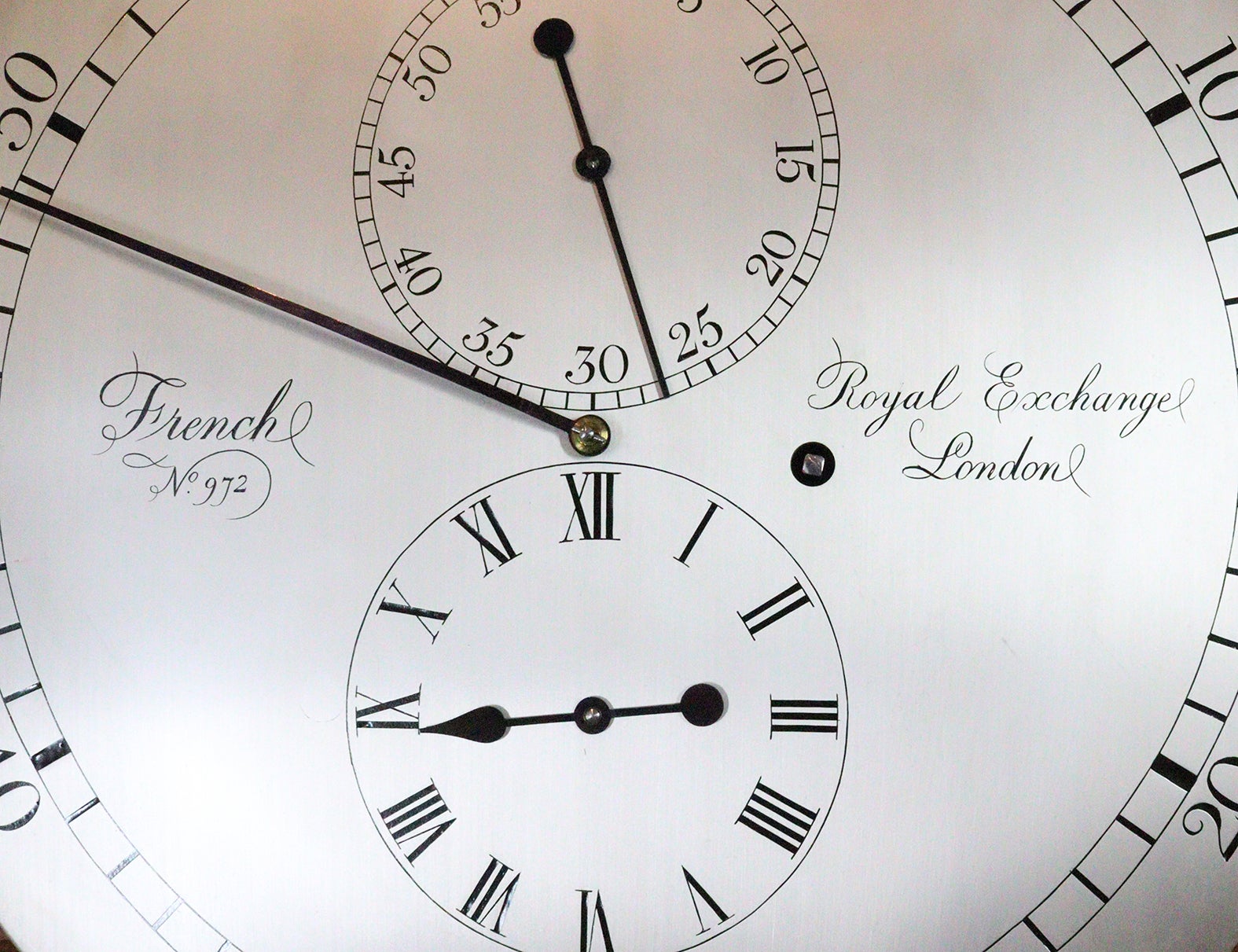
About the Seller
No Reviews Yet
Vetted Professional Seller
Every seller passes strict standards for authenticity and reliability
Established in 2021
1stDibs seller since 2023
7 sales on 1stDibs
Typical response time: 1 hour
- ShippingRetrieving quote...Shipping from: Amersham, United Kingdom
- Return Policy
More From This Seller
View AllA Very Fine Regency Library Clock
Located in Amersham, GB
This eight day single fusee library timepiece is of unusually small proportions, the a four pilars holding the two thick brass plates. The movement with anchor escapement has an adju...
Category
Antique 1830s English Regency Table Clocks and Desk Clocks
Materials
Brass, Steel
Twin Fusee Bracket Clock By Barraud And Lund
Located in Amersham, GB
A striking drum head bracket clock by Barraud and Lund of exceptional quality. The case is made of quarter sawn mahogany with a beautifully crisp silv...
Category
Antique Mid-19th Century English Victorian Mantel Clocks
Materials
Brass
John Leroux, London. Twin Fusee Balloon Clock
By John Leroux
Located in Amersham, GB
An 18th century balloon shaped bracket or table clock by John Leroux of Charing Cross, dating from circa 1790. The waisted case surmounted by a brass pineapple finial over a drum housing the movement. The dial is behind a hinged convex glazed cast brass bezel to front and brass carrying handles to sides, over hipped concave-sided section forming the base. The front has an applied mount of a sunburst mask, the rear with keyhole shaped door incorporating fine scroll-pierced sound fret set within the frame of the case, on generous cavetto moulded skirt base incorporating break-arch recess to apron and with ogee bracket feet.
The five knopped pillar twin fusee bell striking movement with rounded angles to the rectangular plates and anchor escapement regulated by a long bob pendulum with an effective length of approximately 11.5 inches, the backplate signed J. Leroux, London to centre, the 7 inch circular single sheet silvered brass Roman numeral dial signed Leroux, Charing Cross to centre, with fine pierced steel hands and Arabic five minutes to outer track.
An identical clock is illustrated in English Bracket and Mantel Clocks by Andrew Nicholls...
Category
Antique 18th Century English George III Mantel Clocks
Materials
Brass
A Diminutive Bracket Clock by Adams of Lombard Street
By Adams
Located in Amersham, GB
A rosewood and ormolu mounted bracket clock. With an eight day twin fusee movement, signed Adams of Lombard Street on the 5 inch silvered dial and movement back plate. Striking on a ...
Category
Antique Mid-19th Century English William IV Mantel Clocks
Materials
Brass, Ormolu
Miniature Single Fusee Bracket Clock By William Johnston, Strand, London
By Johnson
Located in Amersham, GB
An extremely small single fusee bracket clock in a scalloped mahogany case. The eight day movement having a half deadbeat escapement with a T bar pendulum with hold fast, is beautifu...
Category
Antique 1830s English William IV Table Clocks and Desk Clocks
Materials
Brass, Ormolu
A Rare George III Ten Bell Quarter Chiming Bracket Clock By Allam and Caithness
Located in Amersham, GB
A rare example of a quarter chiming bracket clock made 1800-1805 by John Allam and Thomas Caithness with an eight day triple fusee movement chiming on ten bells. This clock has an un...
Category
Antique Early 1800s English George III Mantel Clocks
Materials
Brass, Steel
You May Also Like
Early 19th Century English Regency Bracket Clock by T. & J. Ollivant
By Thomas Ollivant
Located in Dublin, IE
A very fine English regency period bracket clock with rosewood case, surmounted by a pineapple finial on a bell shaped caddy over a double steeped plinth . Substantial 8 Day twin fusee movement striking the hours on original bell. The 8? painted enamel convex dial...
Category
Antique Early 19th Century English Regency Mantel Clocks
Materials
Brass
English Bracket Clock, 19th Century William lV Period
Located in Hamilton, Ontario
19th century William lV period English bracket clock.
William IV mahogany bracket clock, L. H. Samuel and Co., Liverpool, circa 1830.
8 inch painted dial ...
Category
Antique 19th Century Great Britain (UK) William IV Mantel Clocks
Early 19th century Regency English Mahogany Bracket Clock
Located in Savannah, GA
Unmarked clockworks, but identical case to one with works by English clockmakers Thomas Satcher, 1775, and one by Handley and Moore, 1798-1824.
Figured mahogany dome- top case mounte...
Category
Antique Early 1800s English Regency Mantel Clocks
Materials
Brass
$2,999 Sale Price
20% Off
19th Century Antique Regency Mahogany Bracket Clock by Thomas Moss of London
By Thomas Moss
Located in Devon, GB
A good Regency period mahogany hour striking bracket clock. The lancet style case with pierced brass side frets, lion and ring side handles and claw feet.
The circular silvered and ...
Category
Antique Early 19th Century British Regency Mantel Clocks
Materials
Brass
Early 19th Century Antique Bracket Clock by Grimalde & Johnson of London
By Grimaldi & Johnson
Located in Devon, GB
An antique late George III period ebonized bracket clock by Grimalde and Johnson, strand. This attractive clock of small proportions, has a mou...
Category
Antique 19th Century British Regency Mantel Clocks
Materials
Wood
Outstanding quality antique Victorian mahogany bracket clock
Located in Ipswich, GB
Outstanding quality antique Victorian mahogany bracket clock, having a quality antique Victorian mahogany bracket clock with a ogee top with beautiful scroll and leaf carving detail...
Category
Antique 19th Century British Mantel Clocks
Materials
Brass
